TARA COPP

A hypersonic missile that China launched into space this summer “did circle the globe,” a U.S. official confirmed to Defense One, and the Pentagon is still working through the implications of the surprise test.
The July 27 launch, first reported by the Financial Times, took place as top U.S. military leaders were focused on the rapid fall of Afghanistan and then the 17-day sprint to evacuate more than 124,000 people from Hamid Karzai International Airport.
Senior leaders are now focused more directly on the launch and its implications, the U.S. official said.
In an interview with Bloomberg Television on Wednesday, Joint Chiefs Chairman Gen. Mark Milley said of the hypersonic launch, “I don’t know if it’s quite a Sputnik moment, but I think it’s very close to that. It has all of our attention.”
China’s foreign ministry has described the launch as a peaceful test of a space vehicle.
At a Pentagon press briefing Wednesday afternoon, spokesman John Kirby was asked if defense leaders also view the launch as a possible “Sputnik moment.”
“I don’t think it does any good for us to characterize this and put a label on it, this advancement of capabilities,” Kirby said.
The Financial Times, citing multiple unnamed officials, reported that it was a hypersonic missile, capable of carrying a nuclear warhead, that circled the globe and then headed toward its target.
Arizona Democratic Rep. Ruben Gallego said the launch is a wake-up call to re-calibrate U.S. defense priorities.
“I don’t think it’s time for us to panic, but it certainly requires us to refocus,” said Gallego, a Marine Corps and Iraq War veteran who sits on the House Armed Services Committee.
“We’ve been very aware here on the armed services committee that we’ve been behind the eight ball when it comes to investments in hypersonics, hypersonic research,” he said at the Defense One National Security Forum Wednesday. “We are quickly catching up. But it does show other indications of problems, the fact that we didn’t have the intelligence capability to see this coming, the fact that it took awhile for us to confirm this.”
Milley’s acknowledgement of the launch comes as Pentagon leaders argue about whether the U.S. has fallen dangerously behind China in software and artificial intelligence, a concern that prompted last month’s resignation of the Air Force’s chief software officer.
The launch raises important questions, said John Ferrari, a retired Army two-star and visiting fellow at the American Enterprise Institute.
“What would be interesting to understand is the role of AI in the launch and steering,” Ferrari said. “Maybe the nuclear game has just changed.”
“The question that has to be asked: Is defense really the answer, or do we need to get right to offense?”
The U.S. could bankrupt itself trying to harden every target and build a defensive system against this type of nuclear launch, Ferrari said.
“We have to match the technology,” Gallego said. “I don’t believe we are going to have technology that is capable, [of defending against a launch] at least until we can fully deploy AI technology in order to stop hypersonic missiles—especially those that are being launched from space.”
Matching the technology will allow the U.S. to deter China, or any other actor developing a similar missile, through the same mutual assured destruction deterrence construct that has prevented nuclear war to date, he said.
“I think China is a rational actor,” Gallego said.
The U.S. is developing several types of hypersonic missiles. Three launches last week from Wallops Island, Va., reached hypersonic speeds, while a fourth was scuttled by a booster rocket problem.
“Our own pursuit of hypersonic capabilities is real,” Kirby said. “It’s tangible and we are absolutely working towards being able to develop that capability.”
No comments:
Post a Comment